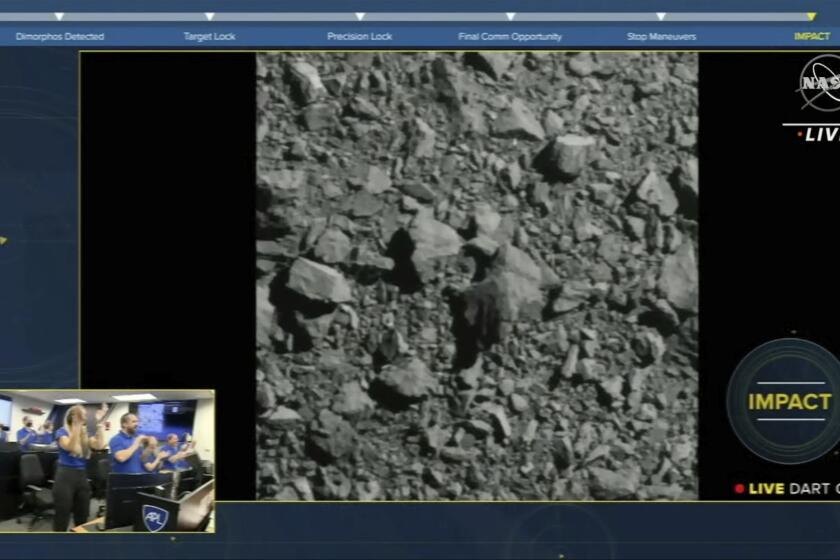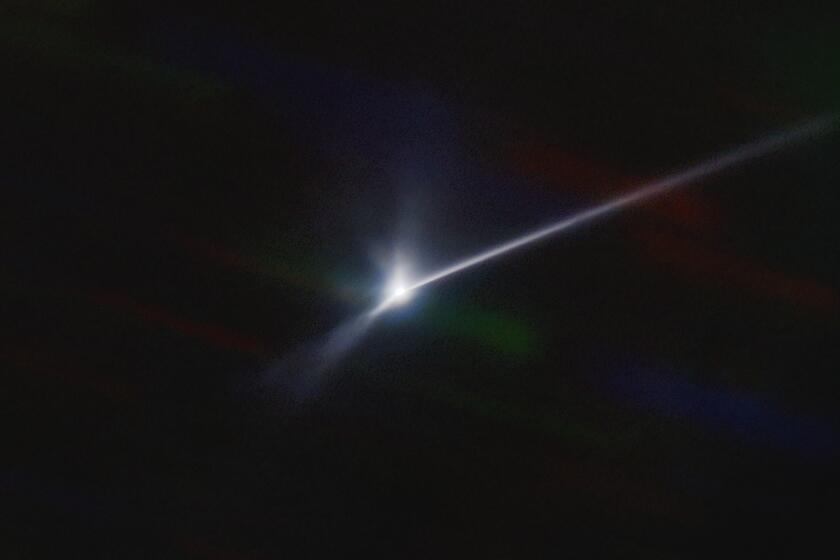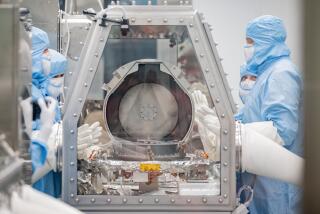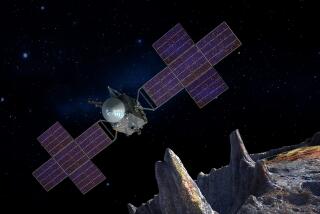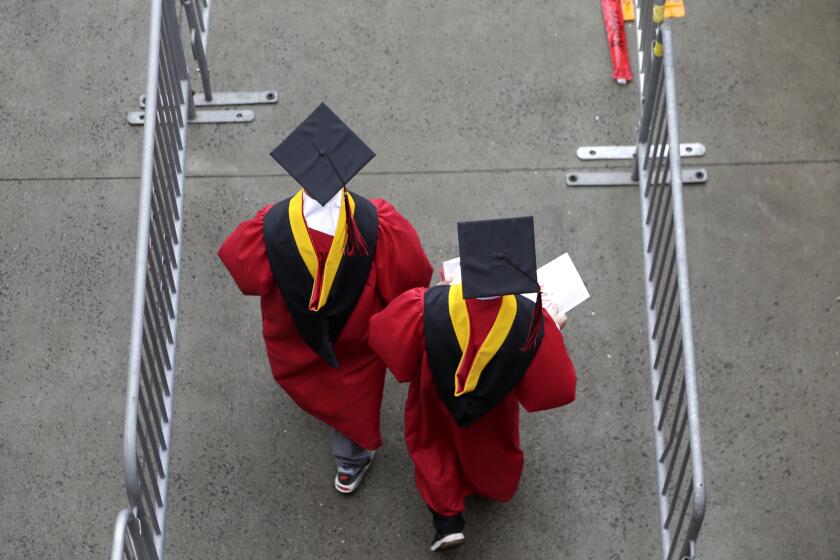Op-Ed: Good news for a change — NASA proves there’s a defense against killer asteroids
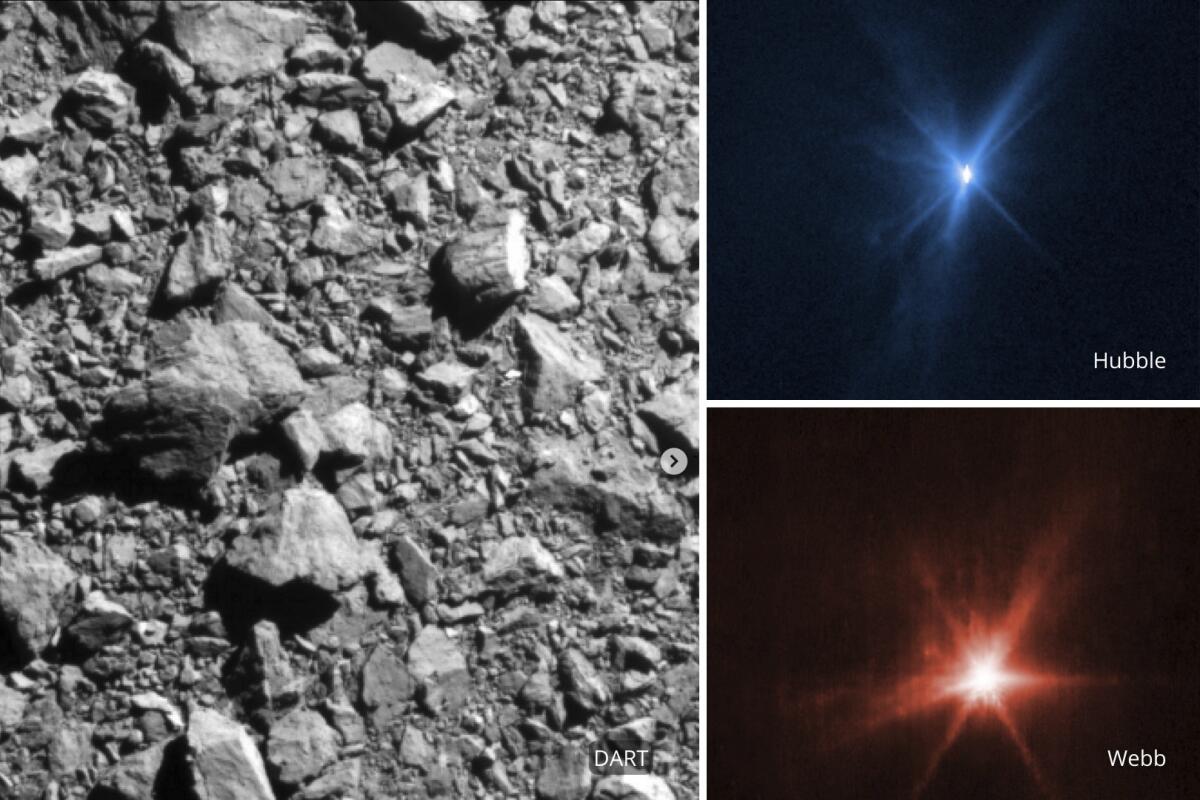
The stock market is dipping, inflation is on the rise and there is no end in sight to the war in Ukraine. But not all the news is bad: Our planet just got a bit safer, thanks to NASA.
In a feat previously relegated to the realms of science fiction, NASA scientists successfully deflected an asteroid from its path.
On Sept. 26, DART, a spacecraft the size of a commercial dryer, hit a nonthreatening asteroid called Dimorphos — and proved that we humans might be capable of mounting an Earthly defense, should a killer asteroid one day head our way.
A NASA spacecraft rammed an asteroid at blistering speed Monday in an unprecedented dress rehearsal for the day a killer rock menaces Earth.
Such a scenario is not far-fetched. Every school kid knows that the reason we don’t see dinosaurs roaming the Earth is that the impact of a giant asteroid wiped them out some 66 million years ago.
In a modern example, an object — perhaps a rocky asteroid, perhaps an icy comet — the size of a 15-story skyscraper exploded over the Tunguska River in Siberia in 1908, releasing energy equivalent to approximately 12-15 megatons of TNT (about a thousand times as powerful as the atom bomb that destroyed Hiroshima).
Most asteroids and comets that enter Earth’s atmosphere vaporize quickly because of the heat produced by friction. The object in Siberia, however, got within 10 miles of the planet’s surface. It flattened 80 million trees over 230 square miles. It left no crater, but the circular pattern of immense destruction is sobering.
Evidence of such events exists all over Earth. Scientists think an explosion similar to Tunguska destroyed Tall el-Hammam, an ancient walled city close to the Dead Sea, around 1650 BC.
One tell-tale sign of a planetary asteroid impact is the presence of the mineral coesite, a variant of quartz that forms only under intense heat and pressure. Mile-wide Meteor Crater in Arizona contains a lot of coesite, as do other sites across the globe. Fortunately, collisions involving an asteroid of the size (about 100 to 170 feet across), makeup and speed that produced Meteor Crater are infrequent, happening once every few hundred years, and are much more likely to hit open ocean or empty territory than a population center.
The debris trail of an asteroid hit by a NASA spacecraft is a comet-like tail consisting of dust and other material spewed from the impact crater.
Still, such a collision could spell the end of a city like Los Angeles, and bigger asteroids could spell the end of the human race. There are thousands of these orbiting rocks in our solar system, and quite a few are on paths that bring them perilously near Earth. NASA has been finding and tracking them for more than two decades in a program sanctioned by Congress. So far none has posed a real threat.
But because the chance is not zero, NASA has looked to develop a defense mechanism. DART (short for Double Asteroid Redirection Test) tested the feasibility of changing the orbit of an asteroid, steering it away from Earth by bumping it into a new trajectory.
DART crashed into Dimorphos at a speed of just over 4 miles per second. More than three dozen telescopes around the world were watching the impact, as were the Hubble and James Webb space telescopes and the LICIACube, an Italian spacecraft designed expressly to observe DART’s slamming into Dimorphos.
Doomsday chances dim: Asteroid won’t hit Earth in 2036, NASA says
On Tuesday, when NASA announced that Dimorphos had indeed been diverted, it also revealed that its experiment worked better than had been predicted. Calculations had estimated that Dimorphos’ orbit around its larger parent asteroid Didymos, which was 11.9 hours, would speed up by 10 minutes after DART crashed into it. The actual time observed was 32 minutes.
Watching NASA’s live telecast on Sept. 26 made for fascinating viewing. DART’s camera spotted Dimorphos only an hour before impact, as a faint spot of light, and it was just five minutes before the crash that the asteroid really came into focus. In the final seconds before DART made contact, the asteroid’s surface — looking like a rocky, boulder-strewn field — filled the screen. Then, true to plan, the screen went dark and the scientists watching it sent up a cheer.
The DART mission isn’t over yet; the data it generated is still being analyzed. The results are nonetheless in: DART has to be classed among the most successful spacecraft NASA has ever launched. For the first time in the history of our species, we‘ve shown we might be able to defend the planet from a massive invader from space.
Saswato R. Das, a physicist by training, writes about science and technology.
More to Read
A cure for the common opinion
Get thought-provoking perspectives with our weekly newsletter.
You may occasionally receive promotional content from the Los Angeles Times.
